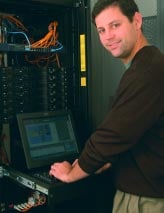Through his research on data storage, Randal Burns helps global computer users quickly view massive amounts of information.

In Steven Spielberg’s 2002 sci-fi thriller Minority Report, criminal investigator John Anderton (Tom Cruise) points his finger at a transparent screen and moves his arm. His glove-mounted sensor slides computer-generated visualizations around the screen. With a twist of the wrist, Anderton stops the action, backing it up to explore the picture from a different angle. Set in 2054, this scene may seem far-fetched, but such complex “steerable” visualizations may be commonplace much sooner. If so, Randal Burns, assistant professor of Computer Science in the Whiting School of Engineering, will be one of the reasons why.
Burns is director of the Hopkins Storage Systems Lab (HSSL, pronounced “Hizzle”), which he founded last year soon after his arrival at the School. The lab, part of the Department of Computer Science, is affiliated with the Johns Hopkins Information Security Institute. Burns studies parallel and distributed computing with a focus on storage systems and distributed data management.
Formerly a computer science researcher at IBM’s Almaden Research Center in San José, Burns has also been a lecturer and research fellow in computer science at the University of California, Santa Cruz (UCSC).
Darrell D.E. Long, director of UCSC’s Storage Systems Research Center, was Burns’ thesis advisor and colleague. “What you look for in a science faculty member is someone who has an intuition for finding interesting problems to work on,” Long observes. “Randal’s one of the best students I’ve ever had.”
Burns says he came to the Whiting School to “conduct studies into distributed and high-performance computer data storage systems” and the technologies that make these systems possible. “Data storage has long been part of many disciplines,” he explains. “This is one place where storage is treated as a discipline in its own right.”
His research has been gaining notice. In March, Burns received a prestigious National Science Foundation CAREER award for young investigators. In September 2002, Burns and Raimond Winslow, director of the new Center for Cardiovascular Bioinformatics and Modeling, were awarded an IBM Shared University Research (SUR) grant, one of the largest single SUR grants to date. Burns will make use of the IBM software and hardware in his research in global-scale file management; meanwhile, cross-disciplinary researchers will explore using the technology to simulate complex models of heart cells, tissues, and organs to look for variations in gene expression. In July 2002, the U.S. Department of Energy awarded Burns an Early Career Principal Investigator Award for research into “Global-Scale File Sharing for High-Performance Cluster Computing.”
“Data storage sounds mundane,” says Burns, “but it is one of the most significant areas of computer research.” Managing the storage software architectures lies at the heart of such sticky issues as information security, control, and power itself. Why? Information is the most valuable asset that any institution, government, or corporation possesses. As more of it piles up, getting at it becomes more difficult and expensive. “Over half of every dollar spent on information technology is spent on storage, and most of that is spent on managing storage,” Burns adds.
Imagine the challenge faced by a large corporation with, say, 50 years’ worth of information stored in databases that span the globe—and the history of computing. “People get stuck in these systems and the investment process ties them in,” he says. “We are trying to build a set of protocols and systems for accessing that data in a variety of locations and storage systems.”
Or consider the predicament of researchers who crunch massive amounts of data. “As you continue to put more and more data sets together into huge scientific databases,” Burns explains, “you have to get into how to handle all of these data.” Distributed computing enables different people at different locations to share data. Without it, he points out, you cannot load a personalized home page such as MyYahoo® because it selects information from a variety of databases and sources and dynamically updates it on millions of computers on demand. “The same is starting to be true in areas such as workflow, file sharing, and distributed light board applications,” he adds.
Parallel computing, on the other hand, turns sharing into massive computing power by bringing several computers together to work a single problem, thereby solving it much more quickly. In parallel computing, Burns predicts, “we will be able to bring computational muscle to bear on big problems.” For example, “In the near future when you get an MRI, the radiologist will be able to compare it to 10,000 other related diagnoses while you wait,” says Burns. “Right now, all the analysis is offline.”
Very soon, Burns predicts, “we are going to have all of the ability to visualize and steer data wherever we want it to go.” The computer scientist pauses to consider the challenges ahead. “If we’re doing our job right, you won’t even notice we’re there,” he says with a laugh. “We’re trying to make the clearest windshield in the world.”
Learn more about Randal Burns and the “Hizzle” lab at hssl.cs.jhu.edu




